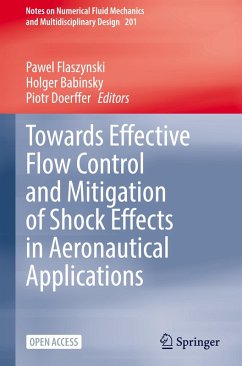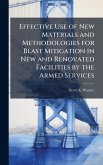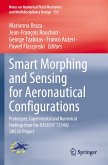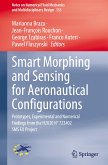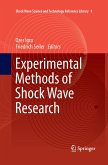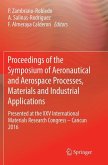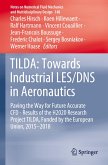Towards Effective Flow Control and Mitigation of Shock Effects in Aeronautical Applications
Herausgegeben:Flaszynski, Pawel; Babinsky, Holger; Doerffer, Piotr
Towards Effective Flow Control and Mitigation of Shock Effects in Aeronautical Applications
Herausgegeben:Flaszynski, Pawel; Babinsky, Holger; Doerffer, Piotr
- Gebundenes Buch
- Merkliste
- Auf die Merkliste
- Bewerten Bewerten
- Teilen
- Produkt teilen
- Produkterinnerung
- Produkterinnerung
This open-access book reports on both experimental and numerical findings from the H2020-funded project TEAMAero (Towards Effective Flow Control and Mitigation of Shock Effects in Aeronautical Applications). It covers novel contributions on improving the fundamental understanding of the physics of shock wave boundary layer interaction, developments in ow control for mitigation of shock effects, and advanced numerical methods for predicting those effects. All in all, this book offers a timely snapshot of research and developments in numerical methods for flow analysis and control, with a…mehr
Andere Kunden interessierten sich auch für
![Nanomaterials for Defense, Aeronautical and Aerospace Applications Nanomaterials for Defense, Aeronautical and Aerospace Applications]() Nanomaterials for Defense, Aeronautical and Aerospace Applications138,99 €
Nanomaterials for Defense, Aeronautical and Aerospace Applications138,99 €![Effective Use of New Materials and Methodologies for Blast Mitigation in New and Renovated Facilities by the Armed Services Effective Use of New Materials and Methodologies for Blast Mitigation in New and Renovated Facilities by the Armed Services]() Scott A WarnerEffective Use of New Materials and Methodologies for Blast Mitigation in New and Renovated Facilities by the Armed Services29,99 €
Scott A WarnerEffective Use of New Materials and Methodologies for Blast Mitigation in New and Renovated Facilities by the Armed Services29,99 €![Smart Morphing and Sensing for Aeronautical Configurations Smart Morphing and Sensing for Aeronautical Configurations]() Smart Morphing and Sensing for Aeronautical Configurations129,99 €
Smart Morphing and Sensing for Aeronautical Configurations129,99 €![Smart Morphing and Sensing for Aeronautical Configurations Smart Morphing and Sensing for Aeronautical Configurations]() Smart Morphing and Sensing for Aeronautical Configurations129,99 €
Smart Morphing and Sensing for Aeronautical Configurations129,99 €![Experimental Methods of Shock Wave Research Experimental Methods of Shock Wave Research]() Experimental Methods of Shock Wave Research106,99 €
Experimental Methods of Shock Wave Research106,99 €![Proceedings of the Symposium of Aeronautical and Aerospace Processes, Materials and Industrial Applications Proceedings of the Symposium of Aeronautical and Aerospace Processes, Materials and Industrial Applications]() Proceedings of the Symposium of Aeronautical and Aerospace Processes, Materials and Industrial Applications113,99 €
Proceedings of the Symposium of Aeronautical and Aerospace Processes, Materials and Industrial Applications113,99 €![TILDA: Towards Industrial LES/DNS in Aeronautics TILDA: Towards Industrial LES/DNS in Aeronautics]() TILDA: Towards Industrial LES/DNS in Aeronautics151,99 €
TILDA: Towards Industrial LES/DNS in Aeronautics151,99 €-
-
-
This open-access book reports on both experimental and numerical findings from the H2020-funded project TEAMAero (Towards Effective Flow Control and Mitigation of Shock Effects in Aeronautical Applications). It covers novel contributions on improving the fundamental understanding of the physics of shock wave boundary layer interaction, developments in ow control for mitigation of shock effects, and advanced numerical methods for predicting those effects. All in all, this book offers a timely snapshot of research and developments in numerical methods for flow analysis and control, with a special emphasis on high-speed flows. It offers extensive information to both researchers and professionals.
Produktdetails
- Produktdetails
- Notes on Numerical Fluid Mechanics and Multidisciplinary Design 201
- Verlag: H2020 Research and Innovation Programme / Springer / Springer Nature Switzerland / Springer, Berlin
- Artikelnr. des Verlages: 978-3-031-86604-3
- Seitenzahl: 392
- Erscheinungstermin: 3. Juli 2025
- Englisch
- Abmessung: 241mm x 160mm x 26mm
- Gewicht: 766g
- ISBN-13: 9783031866043
- ISBN-10: 3031866045
- Artikelnr.: 73212384
- Herstellerkennzeichnung
- Springer-Verlag KG
- Sachsenplatz 4-6
- 1201 Wien, AT
- ProductSafety@springernature.com
- Notes on Numerical Fluid Mechanics and Multidisciplinary Design 201
- Verlag: H2020 Research and Innovation Programme / Springer / Springer Nature Switzerland / Springer, Berlin
- Artikelnr. des Verlages: 978-3-031-86604-3
- Seitenzahl: 392
- Erscheinungstermin: 3. Juli 2025
- Englisch
- Abmessung: 241mm x 160mm x 26mm
- Gewicht: 766g
- ISBN-13: 9783031866043
- ISBN-10: 3031866045
- Artikelnr.: 73212384
- Herstellerkennzeichnung
- Springer-Verlag KG
- Sachsenplatz 4-6
- 1201 Wien, AT
- ProductSafety@springernature.com
Pawel Flaszynski studied mechanical engineering and obtained a Ph.D. in turbomachinery flows and inverse design from Gdansk University of Technology (Poland) in 2002. He then continued his research in the field of aerodynamics and numerical methods, focusing on flow control (streamwise vortex generators) in subsonic and transonic flows, as well as shock-wave/boundary-layer interactions. In 2018, he was awarded a prize for his research on the development of flow control methods in aeronautics by the Ministry of Science and Higher Education (Poland). Since 2014, he has been a professor at the Institute of Fluid Flow Machinery (Polish Academy of Sciences) and the head of the aerodynamics department. He has collaborated on, and coordinated, European projects related to shock-wave/boundary-layer interactions and flow control in compressors, gas turbines, and aircraft wings. He is a member of the European Turbomachinery Society (EUROTURBO) and a representative in the International Society for Airbreathing Engines (ISABE). Holger Babinsky studied aerospace engineering at Stuttgart University in Germany. He obtained a Ph.D. in hypersonic aerodynamics from Cranfield University (UK) in 1994. After 18 months as a research associate at the Shock Wave Research Center of Tohoku University in Sendai, Japan, he returned to the UK to take up a position in the Department of Engineering of the University of Cambridge. He is now the head of fluid mechanics, energy, and turbomachinery as well as a fellow of Magdalene College. His main areas of research are in the field of experimental aerodynamics and associated measurement techniques. Apart from shock-wave/boundary-layer interactions which he has studied for more than 30 years, his current research includes unsteady aerodynamics, road vehicle aerodynamics, and flow control for aircraft wings and engine inlets. He is a fellow of the Royal Academy of Engineering, the Royal Aeronautical Society, and the American Institute of Aeronautics and Astronautics. Piotr Doerffer is a professor at the Institute of Fluid Flow Machinery (a member of the Polish Academy of Sciences, IMP PAN) in Gdansk, Poland. He is involved in both experimental and numerical analyses of transonic flows with shock waves in nozzles and turbine or compressor cascades. His extensive international cooperation stems from long-term research internships at the engineering department of Cambridge University, the mechanical faculty of Karlsruhe University, and the fluid dynamicsdepartment of DLR in Göttingen. The main focus of his work has been flow control aimed at reducing shock-wave-induced separation. He has been actively involved in European collaborative research projects, including EUROSHOCK, AITEB, TLC, ERICKA, FACTOR E-BREAK, as well as coordinating projects like UFAST and TFAST. He has also coordinated Marie Curie projects. Throughout his research career at IMP PAN, he has progressed from an assistant position to the deputy director of the institute.
Part1.Introduction.- Part2.Numerical and experimental methods development.- 1."From high-fidelity high-order to reduced-order modeling for unsteady shock wave/boundary layer interactions ".- 2.Numerical tools for high-fidelity simulation of sblis.- 3."Development of a PVDF Piezo-Film Sensor for Unsteady Wall-Pressure Measurements in sblis".- Part3.Transitional/turbulent SBLI and flow control.- 4.Non-linearities in the low-frequency dynamics of transitional SBLI.- 5.The length and time scales of transitional sblis.- 6."Parameter Influence on Porous Bleed Performance for Shock-Wave/Boundary-Layer Interaction Control".- 7.Unsteady three-dimensional oblique shock wave boundary-layer interactions.- 8.Oblique-shock wave boundary layer interactions control: shock control bumps.- Part4.Airfoil/wing configuration.- 9.Numerical Study of Unsteady Shock/Boundary Layer Interaction.- 10.Numerical study and physical analysis of the transonic interaction and its modification through morphing around supercritical wings at high Reynolds number.- Part5.Transonic compressor.- 11.Numerical investigations of transitional SBLI on a highly loaded-transonic compressor.- 12.Reynolds number effects on shock wave boundary layer interaction in highly loaded compressor stator.- 13."Experimental and Numerical Investigations of SBLI and Flow Control on a Transonic Compressor Cascade ".- 14.Surface roughness effect on SBLI on compressor rotor profile.- 15."Shock Oscillation Mechanisms of Highly Separated Transitional Shock-Wave/Boundary-Layer Interactions".
Part1.Introduction.- Part2.Numerical and experimental methods development.- 1."From high-fidelity high-order to reduced-order modeling for unsteady shock wave/boundary layer interactions ".- 2.Numerical tools for high-fidelity simulation of sblis.- 3."Development of a PVDF Piezo-Film Sensor for Unsteady Wall-Pressure Measurements in sblis".- Part3.Transitional/turbulent SBLI and flow control.- 4.Non-linearities in the low-frequency dynamics of transitional SBLI.- 5.The length and time scales of transitional sblis.- 6."Parameter Influence on Porous Bleed Performance for Shock-Wave/Boundary-Layer Interaction Control".- 7.Unsteady three-dimensional oblique shock wave boundary-layer interactions.- 8.Oblique-shock wave boundary layer interactions control: shock control bumps.- Part4.Airfoil/wing configuration.- 9.Numerical Study of Unsteady Shock/Boundary Layer Interaction.- 10.Numerical study and physical analysis of the transonic interaction and its modification through morphing around supercritical wings at high Reynolds number.- Part5.Transonic compressor.- 11.Numerical investigations of transitional SBLI on a highly loaded-transonic compressor.- 12.Reynolds number effects on shock wave boundary layer interaction in highly loaded compressor stator.- 13."Experimental and Numerical Investigations of SBLI and Flow Control on a Transonic Compressor Cascade ".- 14.Surface roughness effect on SBLI on compressor rotor profile.- 15."Shock Oscillation Mechanisms of Highly Separated Transitional Shock-Wave/Boundary-Layer Interactions".

